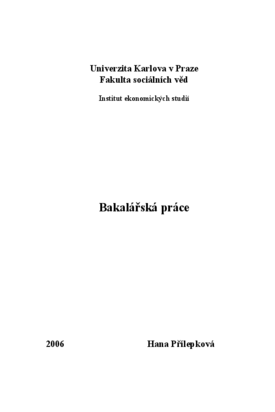Historie evropských měnových unií
The history of the European monetary unions
bakalářská práce (OBHÁJENO)

Zobrazit/
Trvalý odkaz
http://hdl.handle.net/20.500.11956/6357Identifikátory
SIS: 1902
Katalog UK: 990005774890106986
Kolekce
- Kvalifikační práce [18957]
Autor
Vedoucí práce
Oponent práce
Pazderník, Roman
Fakulta / součást
Fakulta sociálních věd
Obor
Ekonomie
Katedra / ústav / klinika
Institut ekonomických studií
Datum obhajoby
23. 6. 2006
Nakladatel
Univerzita Karlova, Fakulta sociálních vědJazyk
Čeština
Známka
Velmi dobře
Práce mapuje měnovou unifikaci evropských zemí od 2. poloviny 19. století do období po 1. světové válce, která probíhala na pozadí kovových měnových systémů. Cílem je poskytnout ucelený pohled na historický vývoj evropských unifikačních snah a odhalit příčiny jejich úspěchů či neúspěchů. První část představuje stručné teoretické uvedení do problematiky měnových unií, pozornost je věnována především teorii optimální měnové oblasti. Zbývající části se již plně zabývají jednotlivými měnovými uniemi vymezeného období. Nejprve sledujeme proces vzniku národních a mezinárodních měnových unií 19. století. Spontánní přechod většiny nejen evropských zemí na zlatý standard v 70. letech 19. století znamenal vytvoření celosvětové měnové unie, postavené na systému pevných směnných kurzů. Závěrečným tématem práce je Rakousko-Uherská měnová unie. Powered by TCPDF (www.tcpdf.org)
This thesis depicts monetary integration of the European states from the second half of the nineteenth century to the period after the First World War, which was taking place against the background of the then metallic monetary systems. The aim is to provide a comprehensive view of the historical developement of integrating tendencies and to reveal the reasons of its successes and failures. The first part provides a brief theoretical introduction, the stress is putted especially on the theory of optimal currency areas. The remaining parts deal with monetary unions of the surveyed period. Firstly we look at the ways in which national and multinational monetary unions of the nineteenth century were realized. The spontaneous adoption of the gold standard by the majority of countries in the 1870s created world monetary union based on a system of fixed exchange rates. Finally we focuse on the Austro-Hungarian monetary union. Powered by TCPDF (www.tcpdf.org)
